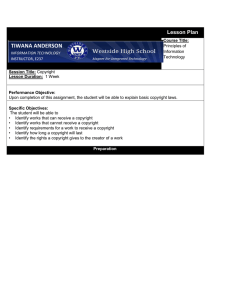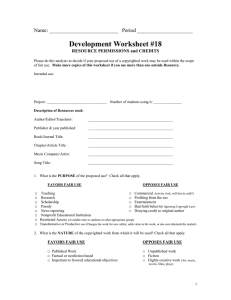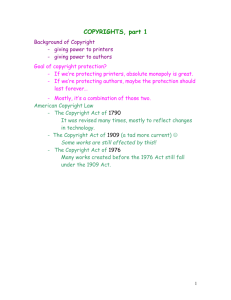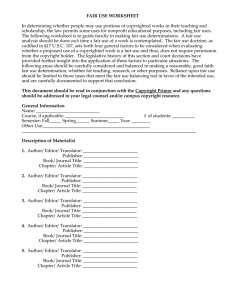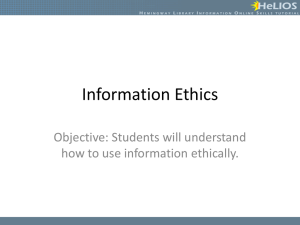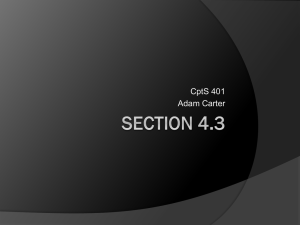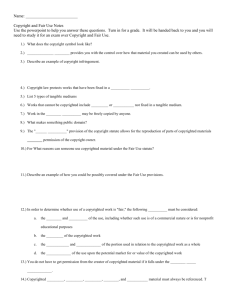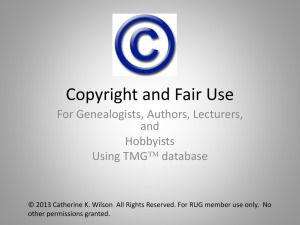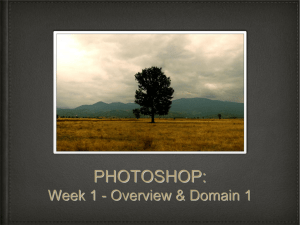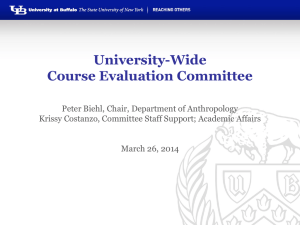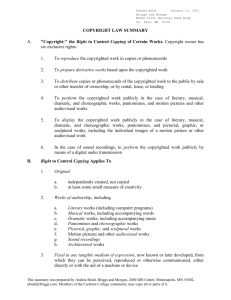RamCT: Copyright and Fair Use in Online Instruction
advertisement
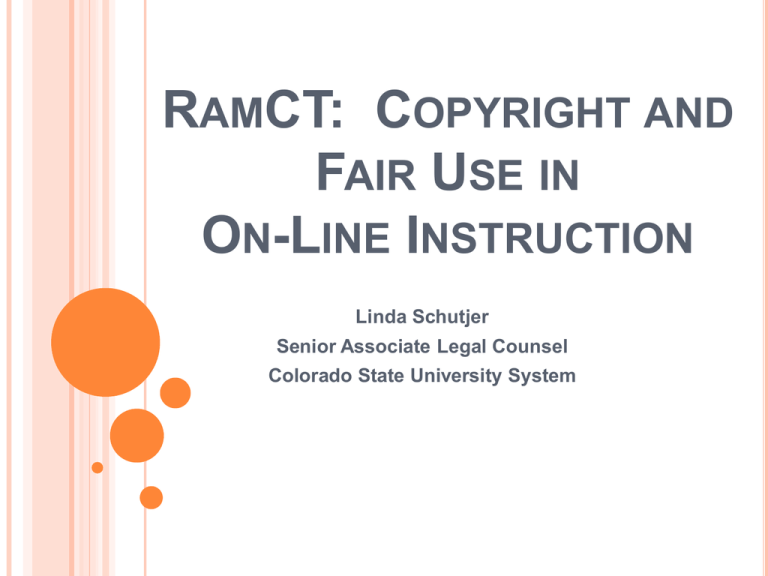
RAMCT: COPYRIGHT AND FAIR USE IN ON-LINE INSTRUCTION Linda Schutjer Senior Associate Legal Counsel Colorado State University System WHAT IS COPYRIGHT? Copyright is a form of protection provided by the laws of the United States to authors of original works of authorship. It is available for both published and unpublished works. It generally gives the owner of the copyright exclusive rights to the work for a period of time before the work goes into the public domain. WHAT DOES COPYRIGHT PROTECT? Works of Authorship – A Person’s Unique Way of Saying Something Fixed in a Tangible Medium – Does not have to be directly perceptible as long as it can be communicated with the aid of a machine or device Original COPYRIGHT EXEMPTIONS §107 - Fair Use Doctrine §109 - First Sale Doctrine §110 – Education Exemptions 110(1) – Classroom or face-to-face teaching 110(2) – TEACH – distance education FOUR FACTOR FAIR USE TEST Purpose and character of the use Nature of the copyrighted work Amount and importance of part used Effect on the potential market for or value of the copyrighted work WHAT IS THE PURPOSE OF THE PROPOSED USE? Favors Fair Use: Not for Profit Teaching Research/Scholarship Criticism Commentary/ Reporting Parody Transformative Restricted Access Does Not Favor Fair Use: For Profit Commercial Entertainment Lack of Attribution Bad Faith Behavior WHAT IS THE NATURE OF THE WORK TO BE USED? Favors Fair Use: Factual Published Not Copyrightable: Listings of ingredients/contents, directions Ideas, concepts, methods, processes Works authored by the US Government Does Not Favor Fair Use: Creative Entertainment Consumable Materials (workbooks, answer sheets) HOW MUCH OF THE COPYRIGHTED WORK WILL BE USED? Favors Fair Use: Small amount Only as much as necessary for the educational purpose Only used for a limited period of time Does Not Favor Fair Use: Large portion or entire work Most important or significant portion – the heart of the work Used year after year WHAT IS THE EFFECT ON THE MARKET OR POTENTIAL MARKET FOR THE WORK? Favors Fair Use: User owns lawfully acquired copy No significant effect on market Copyright holder not able to be identified or located Item out of print or otherwise not available for purchase Does Not Favor Fair Use: Replaces sale of copyrighted work Numerous copies made Use makes copy publically available on the internet Copyright permission readily available FIRST SALE DOCTRINE Section 109 allows for the sale of a copyrighted work without transferring the underlying copyright. Once you have bought a physical copy of a copyrighted work, you can re-sell that work without it constituting a violation of the author’s copyright. In most cases you can even make new works that incorporate the physical work you bought without violating the author’s copyright – e.g. incorporate physical books into a piece of sculpture. CLASSROOM TEACHING EXCEPTION Instructors and students at a non-profit educational institution may use, display, and/or perform in a classroom environment any copyright-protected material or work PROVIDED THAT: The work used was legally obtained The intended use of the work is strictly educational Distribution is in a location designed primarily for educational purposes Teaching and learning occur simultaneously (e.g. not a recording) See TILT Guide: Copyright Essentials for Educators TEACH ACT Technology, Education and Copyright Harmonization Act of 2002 Total revision of distance education exemption Attempts to equalize distance education and classroom teaching TEACH ACT §110(2) – Distance education – digital transmissions of displays of works via digital networks, including still images, in amounts comparable to typical face to face teaching which transmissions are made to students officially enrolled in the class no matter where the students are located TEACH ACT (CONT.) Performances of the following are allowed to be transmitted: An entire non-dramatic literary or musical work Readings from novels, poetry and textbooks Pop music, symphonies “Reasonable and limited” portions of other works Dramatic works Audiovisuals REASONABLE AND LIMITED? “Although what constitutes a ‘reasonable and limited portion’ of a work is not defined in the statute, the legislative history of the Act suggests that determining what amount is permissible should take into account the nature of the market for that type of work and the instructional purposes of the performance. For example, the exhibition of an entire film may possibly constitute a ‘reasonable and limited’ demonstration if the film’s entire viewing is exceedingly relevant toward achieving an educational goal; however, the likelihood of an entire film portrayal being ‘reasonable and limited’ may be rare.” Congressional Research Service Report http://assets.opencrs.com/rpts/RL33516_20060706.pdf TEACH ACT REQUIREMENTS Institution Technology Instructor Materials INSTITUTION REQUIREMENTS Accredited nonprofit educational institution Institute copyright policies Provide informational materials to faculty, staff and students on compliance with copyright laws Provide notice to students that course materials may be subject to copyright protection TECHNOLOGY REQUIREMENTS Transmission of content limited to students officially enrolled in the course Content cannot be retained longer than “class session,” which is not defined Institution should take technological measures to restrict use of content in violation of law Cannot interfere with technology control measures No material can remain on the system longer than necessary to facilitate transmission May retain copies of transmissions provided only used such materials in compliance with law (i.e. TEACH act) INSTRUCTOR REQUIREMENTS Performance or display of materials must be made by, at the direction of, or under actual supervision of an instructor The instructor must use the materials as an integral part of a class session which is offered as a regular part of systematic, mediated instructional activities The materials used by the instructor must be directly related to teaching content – not for entertainment Instructor must use lawfully made and acquired copy MATERIAL REQUIREMENTS “Digital Educational Work” -- Textbooks or other material in any media which are typically purchased by students for use in one or more class sessions may not be used pursuant to the TEACH Act provisions Analog works cannot be converted into digital unless: No digital version is available or A digital version exists but cannot be accessed because it is secured by a technological protection measure that prevents access Amount converted is limited to the amount that is otherwise permitted to be used under the TEACH Act Always include copyright notices/attributions on materials LINKS: Links – You can generally link to materials in your courses. Of course, review the website terms and conditions before you do to make sure you comply with any special requirements they have. You should provide the hyperlink so that it is clear that it is a link to materials outside of the class, as “framing” can be a problem. Generally, you won’t be liable for any infringement represented in the materials you link to – unless you are aware of the infringement and link anyway. That is another reason to link via the web link rather than drawing the materials into your actual course. http://www.bitlaw.com/internet/linking.html INSTRUCTOR / STUDENT CREATED MATERIALS: Author is the owner under CSU policy so if you are not the Author, you will need to treat works by students or other faculty or staff just as if it was third party materials If you do create your own materials, if they include third party images or audio, you will need to consider whether Fair Use or the TEACH Act support your use or whether you need to get permission from the copyright owner AUDIO/VIDEO: Audio – Two Clearances Required: Musical Composition -- notes, lyrics and melodies Copyright(s) usually owned by the music publisher Sound Recording – captured performance Copyright usually owned by the recording company Video – One Clearance – unless audio is included or other copyrighted works shown or used Sampling is not “legal” Your use must be with permission or within an exception such as fair use, classroom use or the TEACH Act HTTP://CCS.COLOSTATE.EDU COPYRIGHT RESOURCES: US Copyright Office: http://www.copyright.gov/ Two Good Sources for Broad Range of Information: http://www.utsystem.edu/ogc/intellectualproperty/ cprtindx.htm http://www.lib.unc.edu/copyright/ Public Domain/Copyright term chart: http://copyright.cornell.edu/resources/publicdom ain.cfm
